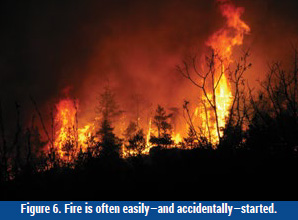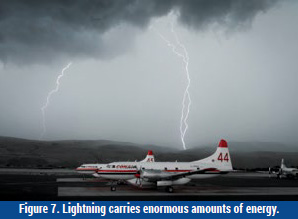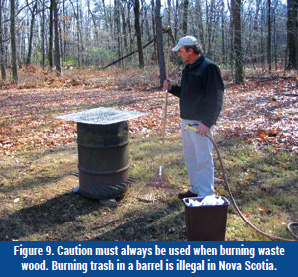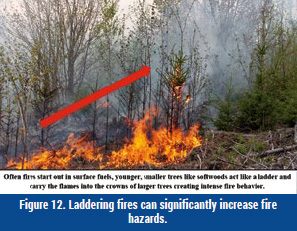Module 16: Wildfire and Your Woodland
Lesson 2 - Woodland Fuels and Wildfire Behaviours
It is important to learn about and manage the amount of fuel that is present on your woodland. A fie is not sustainable without adequate fuel, and that is a good thing when you are a woodland owner!
If a wildfiie begins, it will act according to three factors: weather, topography, and fuel. Fuel is the only factor that you can control. This lesson will address the importance of good fuel management and wildfiie behaviour, in the context of your woodland.
The Essential Ingredients of Fire
Fire needs three ingredients to exist: fuel, oxygen, and a source of ignition (heat). If one ingredient is absent, fie is impossible. Both fie prevention and firefighting depend on removing at least one of these three factors.
Together, the three factors are called the fire triangle. While it may be impossible to control oxygen and heat at the outset of a fie, the availability of fuel can be managed, which is often the key to preventing the spread of fie.
Combine a warm summer day with dry leaves and a carelessly dropped match or cigarette butt, and all the ingredients for a fie are present.
|
|
|
|
Sources of Heat
Despite the presence of large amounts of fuel in most woodland, a source of heat is needed for the fuel to combust. Heat can arrive in the form of a still-burning cigarette butt, a blast of lightning, or a poorly kept campfire. While human activity is by far the most common source of heat, it should be the most easily managed. Often, however, human carelessness knows no bounds!
Lightning
Many people in Nova Scotia believe that most wildfires are started by lightning strikes during spring and summer. This is a common misconception. In Nova Scotia, lightning causes less than 2 per cent of wildfires. While lightning is an intense and powerful source of heat, most of the time it does not strike suitable fuels and the fierce energy is dissipated by the soil.
Lightning is caused by a discharge of static electricity that forms in the atmosphere. When positively charged particles (called ions) build to a critical mass, electricity is released as an outlet of lightning. It may or may not be accompanied by thunder.
|
|
It is common for lightning to seek the shortest route from its point of origin in the atmosphere to the earth. While not all lightning reaches the earth, those lightning bolts that do make a connection are often attracted to tall objects such as trees.
If lightning strikes a tree, the effects can be spectacular. Trees route much of lightning’s energy into the ground, with resulting split trunks, broken branches, and roots that may be blown out of the ground. People who have seen lightning strike a tree often describe the impact as a detonation.
When ground vegetation around a lightning-struck tree is dry, the sudden blast of heat can cause a fie. At the very least, much of the vegetation is killed by the burst of energy. If the organic layer of the soil is sufficiently dry, a fie may smoulder for days beneath the surface before finally becoming a wildfire.
In some instances, a tree that has been standing dead for years (called a snag) provides a good fuel source, and a fie may be ignited within the tree. These snags can smoulder for days. If given suitable dry, hot, breezy weather, they could spread to become a wildfire.
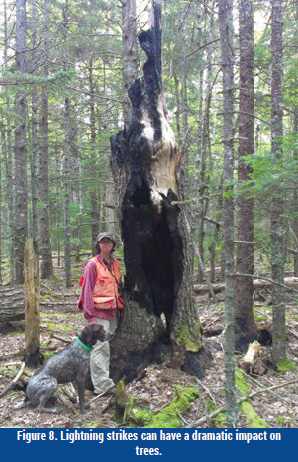 |
Such examples are rare in Nova Scotia. While many lightning strikes happen each year, few ignite fires that reach a significant size. Clearly, lightning strikes cannot be blamed for any appreciable number of fires—even within a decade or longer. Environment Canada monitors lightning strikes across the country, and while they can result in huge wildfires in western Canada, such fires are hardly noticeable in Nova Scotia.
Human Activity
Nearly all wildfires in Nova Scotia are caused by human activities. While large-scale burning for agriculture is mainly restricted to blueberry fields, other forms of burning are still fairly common in Nova Scotia.
Burning trash is an illegal practice, yet some homeowners continue to do it. Although it is not illegal to burn waste wood outdoors in a controlled setting, these fies can escape into the forest, with drastic consequences to populated areas. Campfies, too, can flare up under the right conditions, get into forested areas, and spread rapidly.
|
|
Perhaps less common are fires that are started by mechanical equipment. Metal parts striking stone can cause sparking, while parts can overheat and induce combustion in dry vegetation. Heavy-duty mowers, if operated during extreme fie hazard conditions, can cause sparking and ignition of fires. For woodland owners who keep their access roads mowed as regular maintenance, this can be an important consideration. Mowing vegetation when it is damp can help prevent combustion.
Hot engine or exhaust parts can ignite dry leaves and grass. Simply parking or idling a vehicle over a dry pile of leaves or other vegetation has been known to cause fires. Combustible material can also accumulate in vehicle chassis, and it is always a good idea to keep your vehicle, including ATVs, clean of debris.
The hot engine of a chainsaw, too, can ignite dry vegetation. Keep fuel containers well away from these sites, and use caution when setting your saw down. During extreme fie weather, you may wish to reconsider working in the woods at all until conditions improve.
Other fie-causing human activity includes the crime of arson. Deliberately setting fires for the purpose of nuisance or vandalism can have serious consequences. Arson can have tragic and lasting results, including property damage and lost lives.
Whether accidental or deliberate, wildfires that are the result of human activities can be a significant threat to your woodland property. Making sure proper precautions are taken to prevent fires is everyone’s responsibility, and there are some actions that you can take to minimize the risk your woodland will be affected by wildfire.
How does a Wildfire Start?
In Home Study Module 7 (Woodlot Ecology: Your Living Woodlot), we learned that plants absorb sunlight (radiant energy), carbon dioxide, and water. Through a process called photosynthesis, these compounds are turned into sugars and oxygen. The sugars are used for plant growth and are stored as chemical energy.
When plant material burns, chemical energy is transformed into thermal energy, releasing heat, carbon dioxide, and water. Once fuels reach critical temperatures, gases within the plant material become volatile and will readily burn. Dry leaves, needles, and twigs are fine fuels that burn rapidly once ignition temperatures are reached.
As a fie feeds on these fine fuels, the temperature of the fie rises and the fie is able to consume larger fuels such as ground vegetation, branches, and small trees. If a breeze is present, more oxygen is available to the fie, further increasing its temperature and rate of spread. Under these conditions, a fie may soon grow out of control for one or two people and become a wildfire.
What Factors Influence Wildfire Behaviour?
Once a wildfire has started, fuel, weather, and topography combine to influence the behaviour of the fie. If large amounts of fuel are present across the landscape, the intensity of the wildfie will increase. Weather will affect the amount of moisture present in the fuel, influence the depth to which a fie will burn in the forest floor, and dictate the length of time embers within the ground will smoulder. If the topography of an area is hilly and fie is travelling uphill, its rate of spread will increase.
If enough fuel and oxygen are available, a fie will continue to burn and expand in size. As a fie burns, it preheats fuels that are in its path, accelerating the pace at which it can travel and consuming larger pieces of fuel. If it becomes large enough, a wildfire may even begin to form its own weather!
|
|
In most instances, wildfires are quite predictable in their behaviour, which is of great interest to fie managers. If a fie should start on your woodland, you would also want to know how it will act! Fire behaviour can be predicted by referring to the fie behaviour triangle, a useful tool that forest fie managers have used for decades. The triangle, shown below, depicts fuels, weather, and topography all working together to influence the ways in which fires behave.
|
|
|
|
It should always be remembered that fie will travel uphill faster than on flat terrain. As heat rises, the fuels above the fie will dry and ignite more quickly. If your woodland is located on a hillside, a wildfire starting at the bottom may travel much more quickly than a fie on level ground. This can be an important safety consideration.
Of all the factors that affect a fie’s behaviour, wind speed is the most important. Not only will wind decrease humidity, but a small flame can be quickly fanned into a large blaze if wind is present. A fie will also travel more rapidly as wind speed increases. If a fie is travelling uphill and a wind is pushing it upwards, the fie will travel even more quickly. Once a fie becomes very large and intense, it can create its own weather, to the point of influencing wind speeds and forming fie tornadoes.
|
|
A wildfire at ground level, called a surface fie, can often be effectively controlled. If the fie jumps into the canopy of a forest, suppression efforts become much more difficult. Fies travel from the ground to the crowns of trees by a process called laddering. When forests are dry, laddering can happen rapidly and may be difficult o contain once it has begun. Ladder fuels include understory trees and shrubs that act as steps to convey fie upwards. Once a wildfire has reached tree crowns, it is potentially more dangerous since it will travel more quickly in the presence of wind and will be more difficult o control.
Weather and Climate
Nearly everyone has noticed that the patterns of weather and climate in Nova Scotia are changing. With warmer winters and summers and wetter, windier autumns, the frequency of extreme weather events appears to be increasing. It is important to note the difference between weather and climate in the context of Nova Scotia’s woodlands. Weather is a local atmospheric condition that affects relatively small areas of the landscape over a short period of time. Climate affects weather and is a larger, regional phenomenon that has a much broader time frame, often measured in decades or centuries. Over the long term, the results of climate change can be more significant than changes in weather.
Climate change can influence annual maximum and minimum precipitation and temperature. It can dictate the species of vegetation—including trees—that are growing on your woodland, as well as affecting long-term drought and flooding. Weather patterns follow climate, and both have direct impacts on fie weather and the risks of wildfie.
Scientists have developed ways of measuring the risks of potential wildfie based on data reflecting atmospheric conditions and of flammable substances on and beneath the surface of the ground. These measurements are compiled into a valuable tool called the Fire Weather Index system.
The Fire Weather Index System
The Fire Weather Index (FWI) system is a weather-specific ool for predicting potential fie conditions on any day in Canada. It is a compilation of six factors that together predict the potential intensity of a wildfie. Three factors are associated with the moisture content of forest fuels and three are related to fie behaviour. The FWI does not take into account the types of fuels that may be present or the topography of the landscape.
The six components of the Fire Weather Index are
- Fine Fuel Moisture Code: A rating of the moisture content of litter and other fin fuels, which can be used to predict ease of ignition and fuel flammability.
- Duff Moisture Code: A rating of the moisture content of the upper duff (organic) layers of the soil and medium-size coarse woody debris.
- Drought Code: A rating of the moisture content of the lower layers of organic soil that can be impacted by seasonal drought. This rating can be used to predict the probability of deep smouldering in the duff layer and in larger-size coarse woody debris.
- Initial Spread Index: A rating that takes into account the wind speed and fine fuel moisture code to gauge the rate at which a fie may spread.
- Buildup Index: A combination of Duff Moisture Code and Drought Code, the Buildup Index rates the total amount of fuel available for combustion.
- Fire Weather Index: A rating that combines Initial Spread Index and Buildup Index, the Fire Weather Index predicts fie intensity.
The Fire Weather Index is usually depicted on a map, with different colours representing areas of predicted fie intensity. Blue is associated with low intensity and red is associated with extreme fie intensity. Green, yellow, and orange represent moderate, high, and very high intensity ratings.
The Fire Weather Index System is used to produce Fire Weather Forecast Maps, which are posted online as 8-hour forecasts and 24-hour forecasts. The maps are updated each day during fie season (March to October).
Fire weather forecast indices are also available each day during fire season. They are calculated using five indicators that are collected from more than 30 sites across the province:
- temperature
- relative humidity
- wind direction
- wind speed
- rain quantity forecast for 24 hours
The maps and indices are available at http://novascotia.ca/natr/forestprotection/wildfie/forecasts.asp


